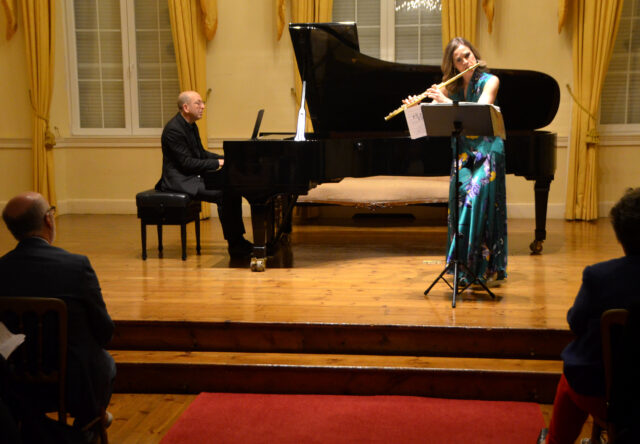Clara Andrada Flutes the Convent
Photos by Joachim Knodt,
Philharmonic Review by C.Wall
Few openings can warm an auditorium like Debussy’s “Prélude à l'après-midi d'un faune”, where Pierre Boulez heard a faun’s flute breathing life into the art of music. Clara Andrada took just three sedate bars to take us from a rainy urban winter to a dreamy Sicilian idyll, from reverie to ecstasy.
The transcription to flute and piano sacrifices some of the finer orchestral effects, as well as the hypnotic power of the faun’s themes, but amidst all the exotic scales and unresolved chords, Andrada’s tones were beautifully shaded, and her fade to silence listlessly theatrical.
Andrada began Poulenc’s Sonata for Flute and Piano rather playfully, with upbeat trills gradually borne down to breathlessness, allowing pianist Alberto Rosado to sound more ominous than mournful. The slow central section seemed unusually emotive, with a heightened contrast between the flute and piano healed by a lyrical progression. The final movement was fast and joyous, and often very sweet.

“Chant de Linos” by André Jolivet took us back to classical mythology, in this case the dirges of ancient Greece, interrupted by wails and primitive dances, all in a 1940s idiom.
From such unappetising ingredients, Andrada and Rosado served up the highlight of the evening. Andrada’s flute thrilled from the beginning, dashing excitedly through wild passages and strange effects, while Rosado led the more contemplative lamentations. As though the unusual phrasing and dynamic changes were not enough, Andrada amplified some of the textural variation through her own harmonic movement.
Prokofiev’s Op. 94 Flute Sonata was composed in the same war years as the Chant de Linos, but modelled on more conventional forms.
The languid opening flowed into winsome harmonies, well balanced between both musicians, though there was one ascendant flute section I couldn’t quite understand. The Scherzo was impressively conversational, despite the virtuosic demands on both piano and flute. The Andante was solemn, a reverential take on Prokofiev’s carved melodies, before the spirited final movement, notable for the weightiness of the piano solo, the athleticism of some flute passages, and the intensity of the finale.
The encore, from a jazz suite by Claude Bolling, leaned more towards film music, though there was a hint of boogie-woogie in Rosado’s piano and a luscious flute section from Andrada. However “modern” this programme might appear to some conservative ears, it provided an immersive experience from the Gibraltar Philharmonic Society.









